Amaranth
Amaranthus is a cosmopolitan genus of annual or short-lived perennial plants collectively known as amaranths.[1] Some amaranth species are cultivated as leaf vegetables, pseudocereals, and ornamental plants. Most of the Amaranthus species are summer annual weeds and are commonly referred to as pigweeds.[2] Catkin-like cymes of densely packed flowers grow in summer or autumn.[3] Amaranth varies in flower, leaf, and stem color with a range of striking pigments from the spectrum of maroon to crimson and can grow longitudinally from 1 to 2.5 metres (3 to 8 feet) tall with a cylindrical, succulent, fibrous stem that is hollow with grooves and bracteoles when mature.[4]
| Amaranthus | |
|---|---|
 | |
| Amaranthus tricolor | |
| Scientific classification | |
| Kingdom: | Plantae |
| Clade: | Tracheophytes |
| Clade: | Angiosperms |
| Clade: | Eudicots |
| Order: | Caryophyllales |
| Family: | Amaranthaceae |
| Subfamily: | Amaranthoideae |
| Genus: | Amaranthus L. |
| Species | |
|
See text | |
There are approximately 75 species in the genus, 10 of which are dioecious and native to North America with the remaining 65 monoecious species endemic to every continent from tropical lowlands to the Himalayas.[5] Members of this genus share many characteristics and uses with members of the closely related genus Celosia. Amaranth grain is collected from the genus. The leaves of some species are also eaten.[6]
Etymology and culture
"Amaranth" derives from Greek ἀμάραντος[7] (amárantos), "unfading", with the Greek word for "flower", ἄνθος (ánthos), factoring into the word's development as amaranth, the unfading flower. Amarant is an archaic variant. The showy Amaranth present in John Milton's garden of Eden is "remov'd from Heav'n" when it blossoms because the flowers "shade the fountain of life".[8] He describes Amaranth as 'immortal' in reference to the flowers that generally do not wither and retain bright reddish tones of color, even when deceased; sometimes referred to as "love-lies-bleeding."
Description
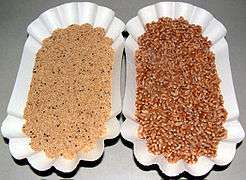
Amaranth is a herbaceous plant or shrub that is either annual or perennial across the genus.[4] Flowers vary interspecifically from the presence of 3 or 5 tepals and stamens, whereas a 7-porate pollen grain structure remains consistent across the family.[4] Species across the genus contain concentric rings of vascular bundles, and fix carbon efficiently with a C4 photosynthetic pathway.[4] Leaves are approximately 6.5–15 centimetres (2 1⁄2–6 inches) and of oval or elliptical shape that are either opposite or alternate across species, although most leaves are whole and simple with entire margins.[4]
Amaranth has a primary root with deeper spreading secondary fibrous root structures.[9] Inflorescences are in the form a large panicle that varies from terminal to axial, color, and sex. The tassel of fluorescence is either erect or bent and varies in width and length between species. Flowers are radially symmetric and either bisexual or unisexual with very small, bristly perianth and pointy bracts.[9] Species in this genus are either monecious (i.e. A. hybridus, L.) or dioecious (i.e. A. arenicola, L.).[9] Fruits are in the form of capsules referred to as a unilocular pixdio that opens at maturity.[9] The top (operculum) of the unilocular pixdio releases the urn that contains the seed.[9] Seeds are circular form from 1-1.5 millimeters in diameter and range in color with a shiny, smooth seed coat.[9] The panicle is harvested 200 days after cultivation with approximately 1,000 to 3,000 seeds harvested per gram.[10]
Taxonomy
Amaranthus shows a wide variety of morphological diversity among and even within certain species. Amaranthus is part of the Amaranthaceae that is part of the larger grouping of the Carophyllales.[4] Although the family (Amaranthaceae) is distinctive, the genus has few distinguishing characters among the 75 species present across six continents.[11] This complicates taxonomy and Amaranthus has generally been considered among systematists as a "difficult" genus and hybridize often.[12]
In 1955, Sauer classified the genus into two subgenera, differentiating only between monoecious and dioecious species: Acnida (L.) Aellen ex K.R. Robertson and Amaranthus.[12] Although this classification was widely accepted, further infrageneric classification was (and still is) needed to differentiate this widely diverse group. Mosyakin and Robertson 1996 later divided into three subgenera: Acnida, Amaranthus, and Albersia.[13] The support for the addition of the subdivision Albersia because of its circumcise, indehiscent fruits coupled with three elliptic to linear tepals to be exclusive characters to members of this subgenus. The classification of these groups are further supported with a combination of floral characters, reproductive strategies, geographic distribution, and molecular evidence.[11][14][15]
The phylogenies of Amaranthus of maximum parsimony and Bayesian analysis of nuclear and chloroplast genes suggest five clades within the genus: Diecious / Pumilus, Hybris, Galapagos, Eurasian/ South African, Australian (ESA), ESA + South American.[14]
Amaranthus includes three recognised subgenera and 75 species, although species numbers are questionable due to hybridisation and species concepts.[4] Infrageneric classification focuses on inflorescence, flower characters and whether a species is monoecious/dioecious, as in the Sauer (1955) suggested classification.[11] Bracteole morphology present on the stem is used for taxonomic classification of Amaranth. Wild species have longer bracteole's compared to cultivated species.[12] A modified infrageneric classification of Amaranthus includes three subgenera: Acnida, Amaranthus, and Albersia, with the taxonomy further differentiated by sections within each of the subgenera.[16]
There is near certainty that A. hypochondriacus is the common ancestor to the cultivated grain species, however the later series of domestication to follow remains unclear. There has been opposing hypotheses of a single as opposed to multiple domestication events of the three grain species.[11][17] There is evidence of phylogenetic and geographical support for clear groupings that indicate separate domestication events in South America and Central America.[11] A. hybridus may derive from South America, whereas A. quentiensis, A. caudatus, and A. hypochondriacus are native to Central and North America.[11][17]
Species
- Amaranthus acanthochiton – greenstripe
- Amaranthus acutilobus – a synonym of Amaranthus viridis[18]
- Amaranthus albus – white pigweed, tumble pigweed
- Amaranthus anderssonii
- Amaranthus arenicola – sandhill amaranth
- Amaranthus australis – southern amaranth
- Amaranthus bigelovii – Bigelow's amaranth
- Amaranthus blitoides – mat amaranth, prostrate amaranth, prostrate pigweed
- Amaranthus blitum – purple amaranth
- Amaranthus brownii – Brown's amaranth
- Amaranthus californicus – California amaranth, California pigweed
- Amaranthus cannabinus – tidal-marsh amaranth
- Amaranthus caudatus – love-lies-bleeding, pendant amaranth, tassel flower, quilete
- Amaranthus chihuahuensis – Chihuahuan amaranth
- Amaranthus crassipes – spreading amaranth
- Amaranthus crispus – crispleaf amaranth
- Amaranthus cruentus – purple amaranth, red amaranth, Mexican grain amaranth
- Amaranthus deflexus – large-fruit amaranth
- Amaranthus dubius – spleen amaranth, khada sag
- Amaranthus fimbriatus – fringed amaranth, fringed pigweed
- Amaranthus floridanus – Florida amaranth
- Amaranthus furcatus
- Amaranthus graecizans
- Amaranthus grandiflorus
- Amaranthus greggii – Gregg's amaranth
- Amaranthus hybridus – smooth amaranth, smooth pigweed, red amaranth
- Amaranthus hypochondriacus – Prince-of-Wales feather, prince's feather
- Amaranthus interruptus – Australian amaranth
- Amaranthus minimus
- Amaranthus mitchellii
- Amaranthus muricatus – African amaranth
- Amaranthus obcordatus – Trans-Pecos amaranth
- Amaranthus palmeri – Palmer's amaranth, Palmer pigweed, careless weed
- Amaranthus polygonoides – tropical amaranth
- Amaranthus powellii – green amaranth, Powell amaranth, Powell pigweed
- Amaranthus pringlei – Pringle's amaranth
- Amaranthus pumilus – seaside amaranth
- Amaranthus quitensis - Mucronate Amaranth
- Amaranthus retroflexus – red-root amaranth, redroot pigweed, common amaranth
- Amaranthus saradhiana
- Amaranthus scleranthoides – variously Amaranthus sclerantoides
- Amaranthus scleropoides – bone-bract amaranth
- Amaranthus spinosus – spiny amaranth, prickly amaranth, thorny amaranth
- Amaranthus standleyanus
- Amaranthus thunbergii – Thunberg's amaranth
- Amaranthus torreyi – Torrey's amaranth
- Amaranthus tricolor – Joseph's-coat
- Amaranthus tuberculatus – rough-fruit amaranth, tall waterhemp
- Amaranthus viridis – slender amaranth, green amaranth
- Amaranthus watsonii – Watson's amaranth
- Amaranthus wrightii – Wright's amaranth
Nutrition
| Nutritional value per 100 g (3.5 oz) | |
|---|---|
| Energy | 1,554 kJ (371 kcal) |
65.25 g | |
| Starch | 57.27 g |
| Sugars | 1.69 g |
| Dietary fiber | 6.7 g |
7.02 g | |
| Saturated | 1.459 g |
| Monounsaturated | 1.685 g |
| Polyunsaturated | 2.778 g |
13.56 g | |
| Tryptophan | 0.181 g |
| Threonine | 0.558 g |
| Isoleucine | 0.582 g |
| Leucine | 0.879 g |
| Lysine | 0.747 g |
| Methionine | 0.226 g |
| Cystine | 0.191 g |
| Phenylalanine | 0.542 g |
| Tyrosine | 0.329 g |
| Valine | 0.679 g |
| Arginine | 1.060 g |
| Histidine | 0.389 g |
| Alanine | 0.799 g |
| Aspartic acid | 1.261 g |
| Glutamic acid | 2.259 g |
| Glycine | 1.636 g |
| Proline | 0.698 g |
| Serine | 1.148 g |
| Vitamins | Quantity %DV† |
| Thiamine (B1) | 10% 0.116 mg |
| Riboflavin (B2) | 17% 0.2 mg |
| Niacin (B3) | 6% 0.923 mg |
| Pantothenic acid (B5) | 29% 1.457 mg |
| Vitamin B6 | 45% 0.591 mg |
| Folate (B9) | 21% 82 μg |
| Vitamin C | 5% 4.2 mg |
| Vitamin E | 8% 1.19 mg |
| Minerals | Quantity %DV† |
| Calcium | 16% 159 mg |
| Iron | 59% 7.61 mg |
| Magnesium | 70% 248 mg |
| Manganese | 159% 3.333 mg |
| Phosphorus | 80% 557 mg |
| Potassium | 11% 508 mg |
| Sodium | 0% 4 mg |
| Zinc | 30% 2.87 mg |
| Other constituents | Quantity |
| Water | 11.3 g |
| Selenium | 18.7 mcg |
| |
| †Percentages are roughly approximated using US recommendations for adults. Source: USDA Nutrient Database | |
Uncooked amaranth grain is 12% water, 65% carbohydrates (including 7% dietary fiber), 14% protein, and 7% fat (table). A 100-gram (3 1⁄2-ounce) reference serving of uncooked amaranth grain provides 1,550 kilojoules (371 kilocalories) of food energy, and is a rich source (20% or more of the Daily Value, DV) of protein, dietary fiber, pantothenic acid, vitamin B6, folate, and several dietary minerals (table). Uncooked amaranth is particularly rich in manganese (159% DV), phosphorus (80% DV), magnesium (70% DV), iron (59% DV), and selenium (34% DV). Cooking decreases its nutritional value substantially across all nutrients, with only dietary minerals remaining at moderate levels.[20] Cooked amaranth leaves are a rich source of vitamin A, vitamin C, calcium, and manganese, with moderate levels of folate, iron, magnesium, and potassium.[21] Amaranth does not contain gluten.[22][23][24]
Phytochemicals
Amaranth grain contains phytochemicals that are not defined as nutrients and may be antinutrient factors, such as polyphenols, saponins, tannins, and oxalates. These compounds are reduced in content and antinutrient effect by cooking.[25][26]
Human uses

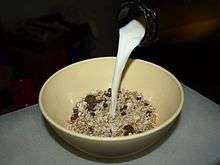
History
The genus is native to Mexico and Central America.[10] In pre-Hispanic times, amaranth was cultivated by the Aztec and their tributary communities in a quantity very similar to maize.[27] Known to the Aztecs as huāuhtli,[28] amaranth is thought to have represented up to 80% of their energy consumption before the Spanish conquest. Another important use of amaranth throughout Mesoamerica was in ritual drinks and foods. To this day, amaranth grains are toasted much like popcorn and mixed with honey, molasses, or chocolate to make a treat called alegría, meaning "joy" in Spanish. Diego Durán described the festivities for the Aztec god Huitzilopochtli (whose name means "left side of the hummingbird"; hummingbirds feed on amaranth flowers). The Aztec month of Panquetzaliztli (7 December to 26 December) was dedicated to Huitzilopochtli. People decorated their homes and trees with paper flags; ritual races, processions, dances, songs, prayers, and finally human sacrifices were held. This was one of the more important Aztec festivals, and the people prepared for the whole month. They fasted or ate very little; a statue of the god was made out of amaranth seeds and honey, and at the end of the month, it was cut into small pieces so everybody could eat a piece of the god. After the Spanish conquest, cultivation of amaranth was outlawed, while some of the festivities were subsumed into the Christmas celebration.
Amaranth is native to the New World and has been first found in the Old World as part of an archaeological excavation in Narhan, India, dated to 1000-800 B.C.E.[29]
Because of its importance as a symbol of indigenous culture, its palatability, ease of cooking, and a protein that is particularly well-suited to human nutritional needs, interest in amaranth seeds (especially A. cruentus and A. hypochondriacus) revived in the 1970s. It was recovered in Mexico from wild varieties and is now commercially cultivated. It is a popular snack in Mexico, sometimes mixed with chocolate or puffed rice, and its use has spread to Europe and parts of North America. Amaranth and quinoa are pseudocereals because of their similarities to cereals in flavor and cooking.
Seed

Several species are raised for amaranth "grain" in Asia and the Americas. The spread of Amaranthus is of a joint effort of human expansion, adaptation, and fertilization strategies. Seeds of Amaranth grain have been found in archeological records in Northern Argentina that date to the mid-Holocene.[9] Archeological evidence of seeds from A. hypochondriacus and A. crutenus found in a cave in Tehuacán, Mexico, suggests amaranth was part of Aztec civilization in the 1400s.[30]
Ancient amaranth grains still used include the three species, Amaranthus caudatus, Amaranthus cruentus, and Amaranthus hypochondriacus.[31] Evidence from single-nucleotide polymorphisms and chromosome structure supports A. hypochondriacus as the common ancestor of the three grain species.[32]
It has been proposed as an inexpensive native crop that could be cultivated by indigenous people in rural areas for several reasons:
- A small amount of seed plants a large area (seeding rate 1 kg/ha).
- Yields are high compared to the seeding rate: 1000 kg or more per hectare.
- It is easily harvested and easily processed, post harvest, as there are no hulls to remove.
- Its seeds are a source of protein.[10][33]
- It has rich content of the dietary minerals, calcium, magnesium, phosphorus, and potassium.[34]
- In cooked and edible forms, amaranth retains adequate content of several dietary minerals.[34]
- It is easy to cook. Boil in water with twice the amount of water as grain by volume (or 2.4 times as much water by weight).
- It grows fast and, in three cultivated species, the large seedheads can weigh up to 1 kg and contain a half-million small seeds.[10]
In the United States, amaranth crop is mostly used for seed production. Most amaranth in American food products starts as a ground flour, blended with wheat or other flours to create cereals, crackers, cookies, bread or other baked products. Despite utilization studies showing that amaranth can be blended with other flours at levels above 50% without affecting functional properties or taste, most commercial products use amaranth only as a minor portion of their ingredients despite them being marketed as "amaranth" products.[35]
Leaves, roots, and stems
Amaranth species are cultivated and consumed as a leaf vegetable in many parts of the world. Four species of Amaranthus are documented as cultivated vegetables in eastern Asia: Amaranthus cruentus, Amaranthus blitum, Amaranthus dubius, and Amaranthus tricolor.[36]
In Indonesia and Malaysia, leaf amaranth is called bayam. In the Philippines, the Ilocano word for the plant is kalunay; the Tagalog word for the plant is kilitis or kulitis. In Uttar Pradesh and Bihar in India, it is called chaulai and is a popular green leafy vegetable (referred to in the class of vegetable preparations called saag). It is called chua in Kumaun area of Uttarakhand, where it is a popular red-green vegetable. In Karnataka in India, it is called harive soppu (ಹರಿವೆ ಸೊಪ್ಪು) . It is used to prepare curries such as hulee, palya, majjigay-hulee, and so on. In Kerala, it is called cheera and is consumed by stir-frying the leaves with spices and red chili peppers to make a dish called cheera thoran. In Tamil Nadu, it is called mulaikkira and is regularly consumed as a favourite dish, where the greens are steamed and mashed with light seasoning of salt, red chili pepper, and cumin. It is called keerai masial. In Andhra Pradesh, this leaf is added in preparation of a popular dal called thotakura pappu in (Telugu). In Maharashtra, it is called shravani maath and is available in both red and white colour. In Orissa, it is called khada saga, it is used to prepare saga bhaja, in which the leaf is fried with chili and onions.
In China, the leaves and stems are used as a stir-fry vegetable, or in soups. In Vietnam, it is called rau dền and is used to make soup. Two species are popular as edible vegetable in Vietnam: dền đỏ (Amaranthus tricolor) and dền cơm or dền trắng (Amaranthus viridis).
A traditional food plant in Africa, amaranth has the potential to improve nutrition, boost food security, foster rural development and support sustainable land care.[37]
In Bantu regions of Uganda and western Kenya, it is known as doodo or litoto.[38] It is also known among the Kalenjin as a drought crop (chepkerta). In Lingala (spoken in the Congo), it is known as lɛngalɛnga or bítɛkutɛku.[39] In Nigeria, it is a common vegetable and goes with all Nigerian starch dishes. It is known in Yoruba as shoko a short form of shokoyokoto (meaning "make the husband fat") or arowo jeja (meaning "we have money left over for fish"). In the Caribbean, the leaves are called bhaji in Trinidad and callaloo in Jamaica, and are sautéed with onions, garlic, and tomatoes, or sometimes used in a soup called pepperpot soup. In Botswana, it is referred to as morug and cooked as a staple green vegetable.
In Greece, green amaranth (A. viridis) is a popular dish called βλήτα, vlita or vleeta. It is boiled, then served with olive oil and lemon juice like a salad, sometimes alongside fried fish. Greeks stop harvesting the plant (which also grows wild) when it starts to bloom at the end of August.
In Brazil, green amaranth was, and to a degree still is, often considered an invasive species as all other species of amaranth (except the generally imported A. caudatus cultivar), though some have traditionally appreciated it as a leaf vegetable, under the names of caruru or bredo, which is consumed cooked, generally accompanying the staple food, rice and beans.
Oil
Making up about 5% of the total fatty acids of amaranth, squalene[40] is extracted as a vegetable-based alternative to the more expensive shark oil for use in dietary supplements and cosmetics.[41]
Dyes
The flowers of the 'Hopi Red Dye' amaranth were used by the Hopi (a tribe in the western United States) as the source of a deep red dye. Also a synthetic dye was named "amaranth" for its similarity in color to the natural amaranth pigments known as betalains. This synthetic dye is also known as Red No. 2 in North America and E123 in the European Union.[42]
Ornamentals

The genus also contains several well-known ornamental plants, such as Amaranthus caudatus (love-lies-bleeding), a vigorous, hardy annual with dark purplish flowers crowded in handsome drooping spikes. Another Indian annual, A. hypochondriacus (prince's feather), has deeply veined, lance-shaped leaves, purple on the under face, and deep crimson flowers densely packed on erect spikes.
Amaranths are recorded as food plants for some Lepidoptera (butterfly and moth) species including the nutmeg moth and various case-bearer moths of the genus Coleophora: C. amaranthella, C. enchorda (feeds exclusively on Amaranthus), C. immortalis (feeds exclusively on Amaranthus), C. lineapulvella, and C. versurella (recorded on A. spinosus).
Ecology
Amaranth weed species have an extended period of germination, rapid growth, and high rates of seed production,[2] and have been causing problems for farmers since the mid-1990s. This is partially due to the reduction in tillage, reduction in herbicidal use and the evolution of herbicidal resistance in several species where herbicides have been applied more often.[43] The following 9 species of Amaranthus are considered invasive and noxious weeds in the U.S and Canada: A. albus, A. blitoides, A. hybridus, A. palmeri, A. powellii, A. retroflexus, A. spinosus, A. tuberculatus, and A. viridis.[44][45]
A new herbicide-resistant strain of Amaranthus palmeri has appeared; it is glyphosate-resistant and so cannot be killed by herbicides using the chemical. Also, this plant can survive in tough conditions. The species Amaranthus palmeri (Palmer amaranth) causes the greatest reduction in soybean yields and has the potential to reduce yields by 17-68% in field experiments.[2] Palmer amaranth is among the "top five most troublesome weeds" in the southeast of the United States and has already evolved resistances to dinitroaniline herbicides and acetolactate synthase inhibitors.[46] This makes the proper identification of Amaranthus species at the seedling stage essential for agriculturalists. Proper weed control needs to be applied before the species successfully colonizes in the crop field and causes significant yield reductions.
An evolutionary lineage of around 90 species within the genus has acquired the C4 carbon fixation pathway, which increases their photosynthetic efficiency. This probably occurred in the Miocene.[47][48]
Gallery
 Love-lies-bleeding (Amaranthus caudatus)
Love-lies-bleeding (Amaranthus caudatus)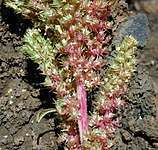 Green amaranth (A. hybridus)
Green amaranth (A. hybridus)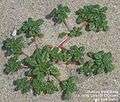 Seabeach amaranth (A. pumilus), an amaranth on the Federal Threatened species List
Seabeach amaranth (A. pumilus), an amaranth on the Federal Threatened species List Red-root amaranth (A. retroflexus)—from Thomé, Flora von Deutschland, Österreich und der Schweiz 1885
Red-root amaranth (A. retroflexus)—from Thomé, Flora von Deutschland, Österreich und der Schweiz 1885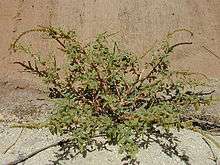 Spiny amaranth (Amaranthus spinosus)
Spiny amaranth (Amaranthus spinosus) Green amaranth (Amaranthus viridis)
Green amaranth (Amaranthus viridis) Popping amaranth (Amaranthus sp.)
Popping amaranth (Amaranthus sp.)- Southern Kerala-style traditional Thoran made with Cheera (amaranth) leaves
.jpg) Amaranth from Chilpancingo
Amaranth from Chilpancingo
See also
References
- "Amaranthaceae | plant family". Encyclopædia Britannica. Retrieved 2015-06-02.
- Bensch; et al. (2003). "Interference of redroot pigweed (Amaranthus retroflexus), Palmer amaranth (A. palmeri), and common waterhemp (A. rudis) in soybean". Weed Science. 51: 37–43. doi:10.1614/0043-1745(2003)051[0037:IORPAR]2.0.CO;2.
- RHS A–Z encyclopedia of garden plants. Dorling Kindersley. 2008. p. 1136. ISBN 978-1405332965.
- Schmid, Rudolf; Judd, Walter S.; Campbell, Christopher S.; Kellogg, Elizabeth A.; Stevens, Peter F.; Donoghue, Michael J.; Judd, Walter S.; Nickrent, Daniel L.; Robertson, Kenneth R.; Abbott, J. Richard; Campbell, Christopher S.; Carlsward, Barbara S.; Donoghue, Michael J.; Kellogg, Elizabeth A. (1 October 2007). "Plant Systematics: A Phylogenetic Approach". Taxon. Wiley. 56 (4): 1316. doi:10.2307/25065934. ISSN 0040-0262. JSTOR 25065934.
- Steckel, Lawrence E. (April 2007). "The Dioecious Amaranthus spp.: Here to Stay". Weed Technology. 21 (2): 567–570. doi:10.1614/WT-06-045.1.
- Wong, James (9 February 2020). "Amaranth tastes as good as it looks | James Wong". The Guardian.
- ἀμάραντος. Liddell, Henry George; Scott, Robert; A Greek–English Lexicon at the Perseus Project
- Milton, John (2000). Paradise lost. Penguin Books. OCLC 647024119.
- Arreguez, Guillermo A.; Martínez, Jorge G.; Ponessa, Graciela (September 2013). "Amaranthus hybridus L. ssp. hybridus in an archaeological site from the initial mid-Holocene in the Southern Argentinian Puna". Quaternary International. 307: 81–85. Bibcode:2013QuInt.307...81A. doi:10.1016/j.quaint.2013.02.035.
- Tucker, Jonathan B. (January 1986). "Amaranth: The Once and Future Crop". BioScience. 36 (1): 9–13. doi:10.2307/1309789. ISSN 0006-3568. JSTOR 1309789.
- Stetter, Markus G.; Schmid, Karl J (2016-11-03). "Analysis of phylogenetic relationships and genome size evolution of the Amaranthus genus using GBS indicates the ancestors of an ancient crop". doi:10.1101/085472. Cite journal requires
|journal=(help) - Costea, Mihai; DeMason, Darleen A. (2001). "Stem Morphology and Anatomy in Amaranthus L. (Amaranthaceae), Taxonomic Significance". Journal of the Torrey Botanical Society. 128 (3): 254. doi:10.2307/3088717. ISSN 1095-5674. JSTOR 3088717. S2CID 84211686.
- Mosyakin, Sergei L.; Clemants, Steven E. (1996). "New Infrageneric Taxa and Combinations in Chenopodium L. (Chenopodiaceae)". Novon. 6 (4): 398. doi:10.2307/3392049. ISSN 1055-3177. JSTOR 3392049.
- Waselkov, Katherine E.; Boleda, Alexis S.; Olsen, Kenneth M. (2018-06-21). "A Phylogeny of the Genus Amaranthus (Amaranthaceae) Based on Several Low-Copy Nuclear Loci and Chloroplast Regions". Systematic Botany. 43 (2): 439–458. doi:10.1600/036364418x697193. ISSN 0363-6445.
- Clouse, J. W.; Adhikary, D.; Page, J. T.; Ramaraj, T.; Deyholos, M. K.; Udall, J. A.; Fairbanks, D. J.; Jellen, E. N.; Maughan, P. J. (2016). "The Amaranth Genome: Genome, Transcriptome, and Physical Map Assembly". The Plant Genome. 9 (1): 0. doi:10.3835/plantgenome2015.07.0062. ISSN 1940-3372. PMID 27898770.
- Sergei L. Mosyakin, Kenneth R. Robertson (1996). "New infrageneric taxa and combinations in Amaranthus (Amaranthaceae)". Ann. Bot. Fennici. 33 (4): 275–281. JSTOR 23726306.CS1 maint: uses authors parameter (link)
- Joshi, Dinesh C.; Sood, Salej; Hosahatti, Rajashekara; Kant, Lakshmi; Pattanayak, A.; Kumar, Anil; Yadav, Dinesh; Stetter, Markus G. (2018-07-10). "From zero to hero: the past, present and future of grain amaranth breeding". Theoretical and Applied Genetics. 131 (9): 1807–1823. doi:10.1007/s00122-018-3138-y. ISSN 0040-5752. PMID 29992369.
- "Search results—The Plant List". theplantlist.org.
- Kumar, Thaliyangal Rajesh; Vishnu, Walsan Kalarikkal; Kumar, Venugopalan Nair Saradamma Anil; Arya, Sindu (2019-05-13). "Amaranthus saradhiana (Amaranthaceae)—a new species from southern Western Ghats of Kerala, India". Phytotaxa. 403 (3): 230–238. doi:10.11646/phytotaxa.403.3.7. ISSN 1179-3163.
- "Amaranth grain, cooked, per 100 g". Nutritiondata.com, Conde Nast; from the USDA National Nutrient Database, SR-21. 2018. Retrieved 20 April 2019.
- "Amaranth leaves, cooked, boiled, drained, without salt, per 100 g". Nutritiondata.com, Conde Nast; from the USDA National Nutrient Database, SR-21. 2018. Retrieved 20 April 2019.
- Lamacchia C, Camarca A, Picascia S, Di Luccia A, Gianfrani C (Jan 29, 2014). "Cereal-based gluten-free food: how to reconcile nutritional and technological properties of wheat proteins with safety for celiac disease patients". Nutrients (Review). 6 (2): 575–90. doi:10.3390/nu6020575. PMC 3942718. PMID 24481131.
- Penagini F, Dilillo D, Meneghin F, Mameli C, Fabiano V, Zuccotti GV (Nov 18, 2013). "Gluten-free diet in children: an approach to a nutritionally adequate and balanced diet". Nutrients (Review). 5 (11): 4553–65. doi:10.3390/nu5114553. PMC 3847748. PMID 24253052.
- Gallagher, E.; T. R. Gormley; E. K. Arendt (2004). "Recent advances in the formulation of gluten-free cereal-based products". Trends in Food Science & Technology (Review). 15 (3–4): 143–152. doi:10.1016/j.tifs.2003.09.012.
- "Legacy: The Official Newsletter of Amaranth Institute" (PDF). Amaranth Institute. 1992. pp. 6–9. Archived from the original (PDF) on 2012-10-12. Retrieved 2011-09-19.
- Hotz C, Gibson RS (2007). "Traditional food-processing and preparation practices to enhance the bioavailability of micronutrients in plant-based diets". J Nutr. 137 (4): 1097–100. doi:10.1093/jn/137.4.1097. PMID 17374686.
- Mapes, Cristina, Eduardo Espitia, and Scott Sessions. "Amaranth." In The Oxford Encyclopedia of Mesoamerican Cultures. : Oxford University Press, 2001. ISBN 0195108159
- Coe, S.D. (1994). America's First Cuisines. University of Texas Press. ISBN 9780292711594.
- Saraswat, K.S.; Sharma, N.K.; Saini, D.C. (1994). Plant Economy at Ancient Narhan (ca. 1300 B.C.-300/400 A.D.) in Excavations at Narhan (1984-1989), Appendix IV. Varanasi, Uttar Pradesh, India: Department of Ancient Indian History, Culture and Archaeology, Banaras Hindu University. pp. 225–337.
- Brenner, D. M.; Baltensperger, D. D.; Kulakow, P. A.; Lehmann, J. W.; Myers, R. L.; Slabbert, M. M.; Sleugh, B. B. (2010-07-23), "Genetic Resources and Breeding ofAmaranthus", Plant Breeding Reviews, John Wiley & Sons, Inc., pp. 227–285, doi:10.1002/9780470650172.ch7, ISBN 978-0-470-65017-2
- Costea, M.; Brenner, D. M.; Tardif, F. J.; Tan, Y. F.; Sun, M. (6 October 2006). "Delimitation of Amaranthus cruentus L. and Amaranthus caudatus L. using micromorphology and AFLP analysis: an application in germplasm identification". Genetic Resources and Crop Evolution. doi:10.1007/s10722-005-0036-3. ISSN 0925-9864.
- Stetter, Markus G.; Zeitler, Leo; Steinhaus, Adrian; Kroener, Karoline; Biljecki, Michelle; Schmid, Karl J. (2016-06-07). "Crossing Methods and Cultivation Conditions for Rapid Production of Segregating Populations in Three Grain Amaranth Species". Frontiers in Plant Science. 7: 816. doi:10.3389/fpls.2016.00816. ISSN 1664-462X. PMC 4894896. PMID 27375666.
- De Macvean & Pöll (1997). Chapter 8: Ethnobotany. Tropical Tree Seed Manual, USDA Forest Service, edt. J.A Vozzo.
- "USDA National Nutrient Database: cooked amaranth grain per 100 grams; Full report". 2014. Retrieved 7 October 2019.
- Delate, Kathleen (2013). "Amaranth: Alternative Agriculture". Iowa State University.
- Costea (2003). Notes on Economic Plants. Economic Botany 57(4): 646-649
- National Research Council (2006-10-27). "Amaranth". Lost Crops of Africa: Volume II: Vegetables. Lost Crops of Africa. 2. National Academies Press. doi:10.17226/11763. ISBN 978-0-309-10333-6. OCLC 34344933. Retrieved 2008-07-15.
- Goode, P. M. (1989). Edible plants of Uganda. Food and Agriculture Organization of the United Nations. pp. 25–6. ISBN 9789251027134.
- Enama, M. (1994). "Culture: The missing nexus in ecological economics perspective". Ecological Economics. 10 (2): 93–95. doi:10.1016/0921-8009(94)00010-7.
- He, Han-Ping; Cai, Yizhong; Sun, Mei; Corke, Harold (2002). "Extraction and Purification of Squalene from Amaranthus Grain". Journal of Agricultural and Food Chemistry. 50 (2): 368–372. doi:10.1021/jf010918p. ISSN 0021-8561. PMID 11782209.
- "Squalene Market Size to Exceed USD 240 Million by 2022". Global Market Insights Inc. 27 April 2016. Retrieved 14 December 2016.
- "The following color additives are not authorized for use in food products in the United States: (1) Amaranth (C.I. 16185, EEC No. E123, formerly certifiable as FD&C red No. 2);" FDA/CFSAN Food Compliance Program: Domestic Food Safety Program Archived 2007-09-29 at the Wayback Machine
- Wetzel et al. (1999). Use of PCR-based molecular markers to identify weedy Amaranthus species. Weed Science 47: 518-523.
- USDA Plant Database. Plants Profile- Amaranthus L
- [Assad, R., Reshi, Z. A., Jan, S., & Rashid, I. (2017). "Biology of amaranths". The Botanical Review, 83(4), 382-436.]
- Culpepper et al. (2006). Glyphosate-resistant Palmer amaranth (Amaranthus palmeri) confirmed in Georgia. Weed Science 54: 620-626.
- Sage, R.F. (2016). "A portrait of the C4 photosynthetic family on the 50th anniversary of its discovery: species number, evolutionary lineages, and Hall of Fame". Journal of Experimental Botany. 67 (14): 4039–4056. doi:10.1093/jxb/erw156. ISSN 0022-0957. PMID 27053721.
- Sage, R.F.; Sage, T.L.; Pearcy, R.W.; Borsch, T. (2007). "The taxonomic distribution of C4 photosynthesis in Amaranthaceae sensu stricto". American Journal of Botany. 94 (12): 1992–2003. doi:10.3732/ajb.94.12.1992. ISSN 0002-9122. PMID 21636394.
Further reading
- Howard, Brian Clark. "Amaranth: Another Ancient Wonder Food, But Who Will Eat It?". National Geographic Online, August 12, 2013.
- Fanton M., Fanton J. Amaranth The Seed Savers' Handbook. (1993)
- Assad, R., Reshi, Z. A., Jan, S., & Rashid, I. (2017). Biology of amaranths. The Botanical Review, 83(4), 382–436.